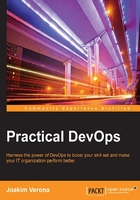
Manual installation
Before we can automate something, we need to understand the corresponding manual process.
Throughout this book, it is assumed that we are using a Red Hat based Linux distribution, such as Fedora or CentOS. Most Linux distributions are similar in principle, except that the command set used for package operations will perhaps differ a bit.
For the exercises, you can either use a physical server or a virtual machine installed in VirtualBox.
First we need the PostgreSQL relational database. Use this command:
dnf install postgresql
This will check whether there is a PostgreSQL server installed already. Otherwise, it will fetch the PostgreSQL packages from a remote yum repository and install it. So, on reflection, many of the potentially manual steps involved are already automated. We don't need to compile the software, check software versions, install dependencies, and so on. All of this is already done in advance on the Fedora project's build servers, which is very convenient.
For our own organization's software though, we will need to eventually emulate this behavior ourselves.
We will similarly also need a web server, in this case, NGINX. To install it, use the following command:
dnf install nginx
The dnf command replaces yum in Red Hat derived distributions. It is a compatible rewrite of yum that keeps the same command line interface.
The software that we are deploying, the Matangle customer relationship database, doesn't technically need a separate database and web server as such. A web server called HTTP Kit is already included within the Clojure layer of the software.
Often, a dedicated web server is used in front of servers built on Java, Python, and so on. The primary reason for this is, again, an issue with the separation of concerns; this time, it is not for the separation of logic but for non-functional requirements such as performance, load balancing, and security. A Java based web server might be perfectly capable of serving static content these days, but a native C-based web server such as Apache httpd or NGINX still has superior performance and more modest memory requirements. It is also common to use a frontend web server for SSL acceleration or load balancing, for instance.
Now, we have a database and a web server. At this point, we need to build and deploy our organization's application.
On your development machine, perform the following steps in the book's unpacked source archive directory:
cd ch3/crm1 lein build
We have now produced a Java archive that can be used to deploy and run the application.
Try out the application:
lein run
Point a browser to the URL presented in the console to see the web user interface.
How do we deploy the application properly on our servers? It would be nice if we could use the same commands and mechanisms as when we installed our databases and webservers. We will see how we do that in Chapter 7, Deploying the Code. For now, just running the application from a shell will have to suffice.